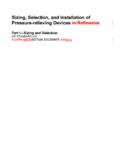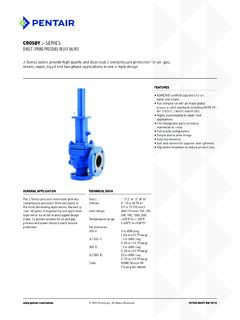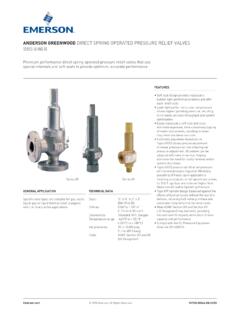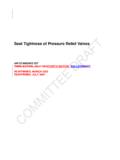Transcription of PRESSURE SAFETY RELIEF VALVES - Parcol
1 PRESSURE SAFETY RELIEF VALVESTECHNICAL BULLETIN 3 PRESSURE SAFETY RELIEF VALVES TECHNICAL BULLETIN 3-I TECHNICAL BULLETIN 3-I PRESSURE SAFETY RELIEF VALVES 1 0. FOREWORD This technical bulletin is dedicated to those PRESSURE relieving devices which fall within the definition of direct-loaded SAFETY VALVES , produced by Parcol since the beginning of the Seventies. The information contained in this document derive from Parcol experience and internal instructions and are basically in accordance with the international standards listed in the following paragraph.
2 1. NORMATIVE REFERENCE API STANDARD 520 Part I (2008), Sizing, Selection and Installation of PRESSURE -relieving Devices in Refineries Sizing and selection API RECOMMENDED PRACTICE 520 Part II (2003), Sizing, Selection and Installation of PRESSURE -relieving Devices in Refineries Installation API STANDARD 526 (2009), Flanged Steel PRESSURE - RELIEF VALVES API STANDARD 527 (1991), Seat tightness of PRESSURE - RELIEF VALVES ISO 4126-1 (2004)
3 , SAFETY devices for protection against excessive PRESSURE SAFETY VALVES ISO 4126-7 (2004), SAFETY devices for protection against excessive PRESSURE Common data ISO 4126-9 (2008), SAFETY devices for protection against excessive PRESSURE Application and installation of SAFETY devices excluding stand-alone bursting disc SAFETY devices ISO-WD 4126-11 (2011), SAFETY devices for protection against excessive PRESSURE Performance testing 2. TERMS AND DEFINITIONS Direct loaded SAFETY valve SAFETY valve in which the loading due to the fluid PRESSURE underneath the valve disc is opposed only by a direct mechanical loading device such as a weight, lever and weight, or a spring.
4 SAFETY valve Automatic PRESSURE -relieving device actuated by the static PRESSURE upstream of the valve and characterized by a rapid full opening or pop action. It is normally used for gas or vapour service. RELIEF valve Automatic PRESSURE -relieving device actuated by the static PRESSURE upstream of the valve. The valve opens in proportion to the increase in PRESSURE over the opening PRESSURE . It is primarily used for liquid service. SAFETY - RELIEF valve Automatic PRESSURE relieving device actuated by the static PRESSURE upstream the valve.
5 It is suitable for use as either a SAFETY or RELIEF valve, depending on the application. Max allowable working PRESSURE (MAWP) Maximum allowable working PRESSURE for operation, in accordance to manufacturing codes and service conditions adopted as the basis for design. Accumulation PRESSURE increase over the MAWP value, expressed as percentage of the MAWP PRESSURE , allowed in the pressurized system. Maximum allowable accumulations are established by applicable codes for operating and fire contingencies.
6 Set PRESSURE (pset) Predetermined PRESSURE at which a SAFETY valve under operating conditions commences to open. It is expressed in gauge units. Three different ways may be used to detect the set PRESSURE depending on the assigned definition: - start of opening, which may be checked measuring the lift or hearing/seeing a continuous outflow; - opening PRESSURE , easily recognizable by the sudden movement of the disc (applicable only to compressible fluids).
7 - start-to-leak PRESSURE , may be easily detected as soon as the first bubble or drop comes out (applicable only to VALVES having a perfect seal, with resilient seats). PRESSURE SAFETY RELIEF VALVES TECHNICAL BULLETIN 3-I 2 Cold-differential test PRESSURE PRESSURE at which the valve is adjusted to open on the test bench, including the corrections for service conditions of back PRESSURE , temperature, or both. Overpressure (ovp) PRESSURE increase over the set PRESSURE , at which the SAFETY valve attains the lift specified by the manufacturer, usually expressed as a percentage of the set PRESSURE .
8 It is the overpressure used to certify the SAFETY valve. Relieving PRESSURE (p1) PRESSURE used for the sizing of a SAFETY valve which is greater than or equal to the set PRESSURE plus overpressure. Lift Actual travel of the valve disc away from the closed position. Coefficient of discharge Value of actual flowing capacity (from tests, by Manufacturer) divided by the theoretical flowing capacity (from calculation). Blowdown (bd) Difference between the set PRESSURE and the reseating PRESSURE , usually expressed as percentage of the set PRESSURE .
9 Back PRESSURE (pb) PRESSURE on the discharge side of SAFETY - RELIEF valve, due to the PRESSURE existing in the downstream system. It is the sum of the built-up and of the superimposed back PRESSURE . It is expressed as: - percentage of relieving PRESSURE , calculated in absolute units for compressible fluids and in gauge units for incompressible fluids, according to ISO 4126; - percentage of set PRESSURE , calculated in gauge units, according to API. Built-up back PRESSURE PRESSURE existing at the outlet of a SAFETY valve caused by flow through the valve and the discharge system.
10 Superimposed back PRESSURE PRESSURE existing at the outlet of a SAFETY valve at the time when the device is required to operate. It may be constant or variable. Flow area Minimum cross-sectional flow area between inlet and seat used to calculate the theoretical flow capacity. TECHNICAL BULLETIN 3-I PRESSURE SAFETY RELIEF VALVES 3 3. DESCRIPTION AND OPERATING CRITERIA SAFETY - RELIEF VALVES may be considered as stop VALVES that close using a steady force insisting directly on the disc, thus no external actuator is needed.












